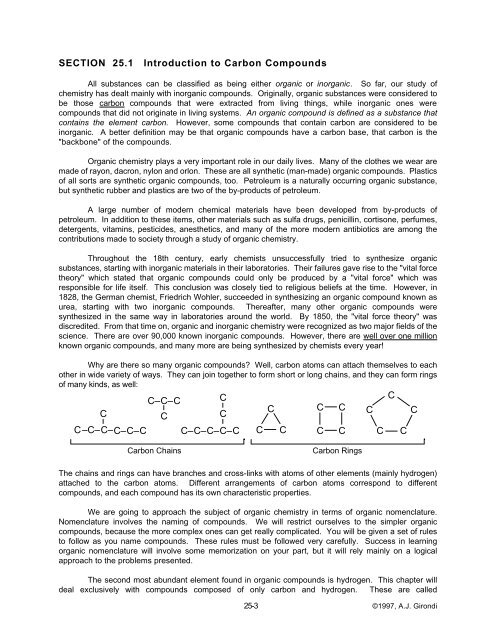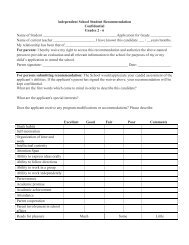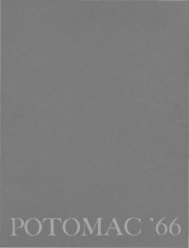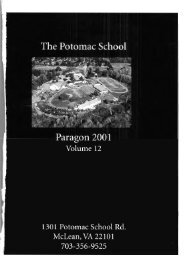Active Learning In Chemistry Education - Potomac School
Active Learning In Chemistry Education - Potomac School
Active Learning In Chemistry Education - Potomac School
Create successful ePaper yourself
Turn your PDF publications into a flip-book with our unique Google optimized e-Paper software.
SECTION 25.1 <strong>In</strong>troduction to Carbon Compounds<br />
All substances can be classified as being either organic or inorganic. So far, our study of<br />
chemistry has dealt mainly with inorganic compounds. Originally, organic substances were considered to<br />
be those carbon compounds that were extracted from living things, while inorganic ones were<br />
compounds that did not originate in living systems. An organic compound is defined as a substance that<br />
contains the element carbon. However, some compounds that contain carbon are considered to be<br />
inorganic. A better definition may be that organic compounds have a carbon base, that carbon is the<br />
"backbone" of the compounds.<br />
Organic chemistry plays a very important role in our daily lives. Many of the clothes we wear are<br />
made of rayon, dacron, nylon and orlon. These are all synthetic (man-made) organic compounds. Plastics<br />
of all sorts are synthetic organic compounds, too. Petroleum is a naturally occurring organic substance,<br />
but synthetic rubber and plastics are two of the by-products of petroleum.<br />
A large number of modern chemical materials have been developed from by-products of<br />
petroleum. <strong>In</strong> addition to these items, other materials such as sulfa drugs, penicillin, cortisone, perfumes,<br />
detergents, vitamins, pesticides, anesthetics, and many of the more modern antibiotics are among the<br />
contributions made to society through a study of organic chemistry.<br />
Throughout the 18th century, early chemists unsuccessfully tried to synthesize organic<br />
substances, starting with inorganic materials in their laboratories. Their failures gave rise to the "vital force<br />
theory" which stated that organic compounds could only be produced by a "vital force" which was<br />
responsible for life itself. This conclusion was closely tied to religious beliefs at the time. However, in<br />
1828, the German chemist, Friedrich Wohler, succeeded in synthesizing an organic compound known as<br />
urea, starting with two inorganic compounds. Thereafter, many other organic compounds were<br />
synthesized in the same way in laboratories around the world. By 1850, the "vital force theory" was<br />
discredited. From that time on, organic and inorganic chemistry were recognized as two major fields of the<br />
science. There are over 90,000 known inorganic compounds. However, there are well over one million<br />
known organic compounds, and many more are being synthesized by chemists every year!<br />
Why are there so many organic compounds? Well, carbon atoms can attach themselves to each<br />
other in wide variety of ways. They can join together to form short or long chains, and they can form rings<br />
of many kinds, as well:<br />
C<br />
C<br />
C– C– C<br />
C<br />
C<br />
C C C C C<br />
C<br />
C–C–C– C– C–C C–C–C–C–C C C C C C C<br />
Carbon Chains<br />
Carbon Rings<br />
The chains and rings can have branches and cross-links with atoms of other elements (mainly hydrogen)<br />
attached to the carbon atoms. Different arrangements of carbon atoms correspond to different<br />
compounds, and each compound has its own characteristic properties.<br />
We are going to approach the subject of organic chemistry in terms of organic nomenclature.<br />
Nomenclature involves the naming of compounds. We will restrict ourselves to the simpler organic<br />
compounds, because the more complex ones can get really complicated. You will be given a set of rules<br />
to follow as you name compounds. These rules must be followed very carefully. Success in learning<br />
organic nomenclature will involve some memorization on your part, but it will rely mainly on a logical<br />
approach to the problems presented.<br />
The second most abundant element found in organic compounds is hydrogen. This chapter will<br />
deal exclusively with compounds composed of only carbon and hydrogen. These are called<br />
25-3 ©1997, A.J. Girondi













